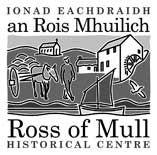
Professor John Stewart Cameron CBE
romhc Thursday, 5 October 2023
We are sorry to announce the death of this good friend of the Historical Centre, a frequent and welcome sojourner in Tigh na Bochd in Ardtun. He was a leading nephrologist who founded a globally renowned kidney unit at Guy’s hospital, in recognition of which he was awarded a CBE. An obituary in the Guardian of 30 September gives a very full picture, including a colleague’s description of him as “the most curiously intelligent doctor I have ever known. We used to say at Guy’s if you wanted to know anything about anything you had to go to the library or better still ask Stewart.” In his spare time he researched the rich history of the Ross and the fruits of years of scholarship, and his passion for this place, resulted in A History of the Ross of Mull, first published in 2014.
All of us at the Centre appreciated his involvement over the years. He has left a significant presence in his writing, and in peoples’ hearts, too. Having written a lively account of John Keats’ walk across Mull to visit Staffa in 1818, Stewart joined a local group 200 years later, retracing a small part of that journey. Humbly and cheerfully, he walked with us.
At the moment we are hoping to reprint the second edition of A History of the Ross of Mull (2019). It is 360 A4 pages long and like all his writing readable and accessible, minutely researched and beautifully illustrated. It sells steadily and profits go to the Centre. It reflects both his deep interest in history and his sense of belonging to Scotland and to Mull. In his introduction Stewart wrote:
“So why bother to write a history of a poorly documented area where little of note happened, no great battles took place, no great men were born or lived and (outside of Iona) little was innovated over the years? The main answer must be because we live here – and want to know how the people of the area … fared over the centuries …The second answer is because every little patch of land reflects in its ‘microhistory’ the pressures, events and movements of past times from which we can learn about greater events. The advent of the Scots to Argyll, then the Vikings, the influence of the Normans, clan history, the Reformation, the wars of Catholic and Protestant royal houses, the wars of the 18th century abroad, the advent of steam then petrol driven transport on sea and land, the coming of the great sheep, the clearances, the potato famine, national legislation ranging from salt taxes to land tenure and finally two devastating world conflicts all impacted on shaped our local history.”
Our condolences, mingled with gratitude for his life and the enthusiasm he shared, go to his family, particularly his daughter Sheena and his second wife, Alison.
JSP
Header image: Portrait of Stewart in later years (Cameron family)
Below: ‘He walked with us’ Stewart Cameron at Derrynacullen – on the Keats walk (Jan Sutch Pickard)

